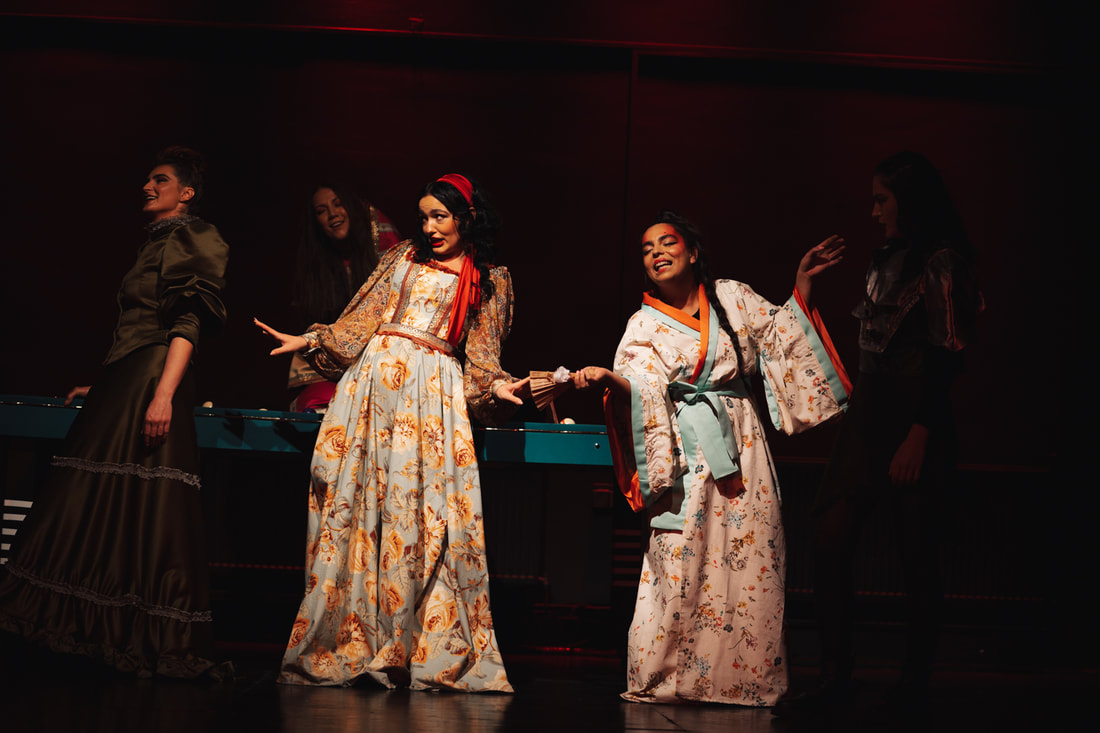Reviewed by Mirela GracanacWhere do women in the Balkans, especially in Kosovo, stand? To reflect the position of women in the region it can be helpful to look elsewhere. Caryl Churchill’s 1982 play Top Girls was presented as part of the Kosovo Theatre Showcase in a production directed by Skurte Aliu.
Although the play is primarily related to the socio-economic situation in Britain in the 80s of the last century and the appointment of Margaret Thatcher as Prime Minister, Aliu’s staging managed to fit the play into the context of the life of a modern woman and to give an impression of the genesis of women's position in different social roles. When the protagonist Marlene points a lamp at individuals in the audience at the very beginning of the play, she breaks the barrier and suggests to the audience that the question on stage will be a question for all of us, and not some story from a book that should entertain us. Top Girls is a play about different women in different times, but also about strong women who managed to overcome the gender roles of the time in which they lived. The character of Marlene, a successful 20th century modern business-woman who has succeeded in a male-dominated business world, holds the story together. The first act brings on stage five women from different historical periods: Isabella Bird, a 19th world traveler and writer, Lady Nijo, who had an extramarital union with the Japanese emperor, and later became a Buddhist nun, Dull Gret, famed as the subject of a painting by Bruegal, Pope Joan, who became a Pope during the Middle Ages, and Patient Griselda, a fictional character from medieval known for her endless patience. Marlene has received a promotion at her place of work, an employment agency, and decides to invite these five women from five different historical periods to help her celebrate, during which they present their individual stories on stage. This combination of women and their stories, some real and some fictional, show us what it means to be a woman in the 13th century who wants to be educated, or what it means to be a model for a great painter, also evokes certain feelings that Marlene carries within herself. The appearance of these women on stage, the way they present the story, their expressions and demeanour give the impression of the power they have due to their success in overcoming social constraints. The dance performance that divides the first and the second scene, unites femininity and anger. That opens up the question of how the unity functions in regard to what a woman is and can be, and what is required of her, and what limits her social position. The first scene is a very dynamic presentation of the fate of each of these women, and the expressiveness and enthusiasm with which they present their stories gives this scene a somewhat grotesque charge. The dance sequence exudes a struggle between femininity and the attitude that the women have while dancing, trying to bring out the unity of the female body on the one hand and a masculine posture and attitude on the other. After the dance sequence, there is a scene where Marlene comes to visit her sister and her daughter Angie. The entire conversation between these three women is coloured by tension and ambiguity. To understand the play, it is necessary to understand the social positions which Marlene and her sister possess. While Marlene is a woman who refuses to conform to the imperative of social roles even though she has had to pay a price that even a successful businesswoman cannot avoid, her sister is a classic representative of the working class and the domestic mentality. In their discussion, long-buried problems emerge into unfixable deviations. Although Marlene is the epitome of power and strength throughout the play, at the end we also see her insecurities and regrets regardless of the success she has achieved. This conversation brings the unraveling of family relationships in which the roles of a mother are consciously taken but never fully accepted. The very end of the play brings a sense of incompleteness, a lack of concrete conclusion - while Marlene drinks another glass of wine, Angie wakes up, and in a somnambulant and almost hypnotized state, several times verbalizes the feeling of fear and chills that overwhelm her. Does such an ending symbolize the constant of a woman's life, in which she, whether successful or not, lives out a predestined life? It is interesting to note that much of the central scene of the original play – set in Marlene’s employment agency - was omitted from this performance. It seems the director wanted to illustrate deviations that are especially important for the role of Kosovar women, so I can assume that the scenes he focused on were crucial and sufficient to open up and problematize the issue to its limit. This was the only play by a Western author at the showcase. It is interesting that one of the guests at Marlene's dinner is a Japanese concubine, which could refer to the relations of the West towards the Orient, as well as in the context of the performance of this piece in the Balkans. We can find a connection with the relationship of the West towards the Balkans as a place beyond the boundaries of culture, but with the same problems. Produced by: Dodona City Theatre of Prishtina and Artpolis//Written by: Caryl Churchill // Directed by: Shkurtë Aliu // With: Donikë Ahmeti, Vjosë Tasholli, Molikë Maxhuni, Zhaneta Xhemajli, Zana Berisha, Blerta Gubetini // Set design: Bekim Korça // Costumes: Arbnor Brahimi // Music: Trimor Dhomi // Choreography: Robert Nuha // Lights: Skënder Latifi
0 Comments
Leave a Reply. |
Kosovo Theatre ReviewsReviews and creative responses to theatre productions in Kosovo Archives
November 2022
Categories |

 RSS Feed
RSS Feed
